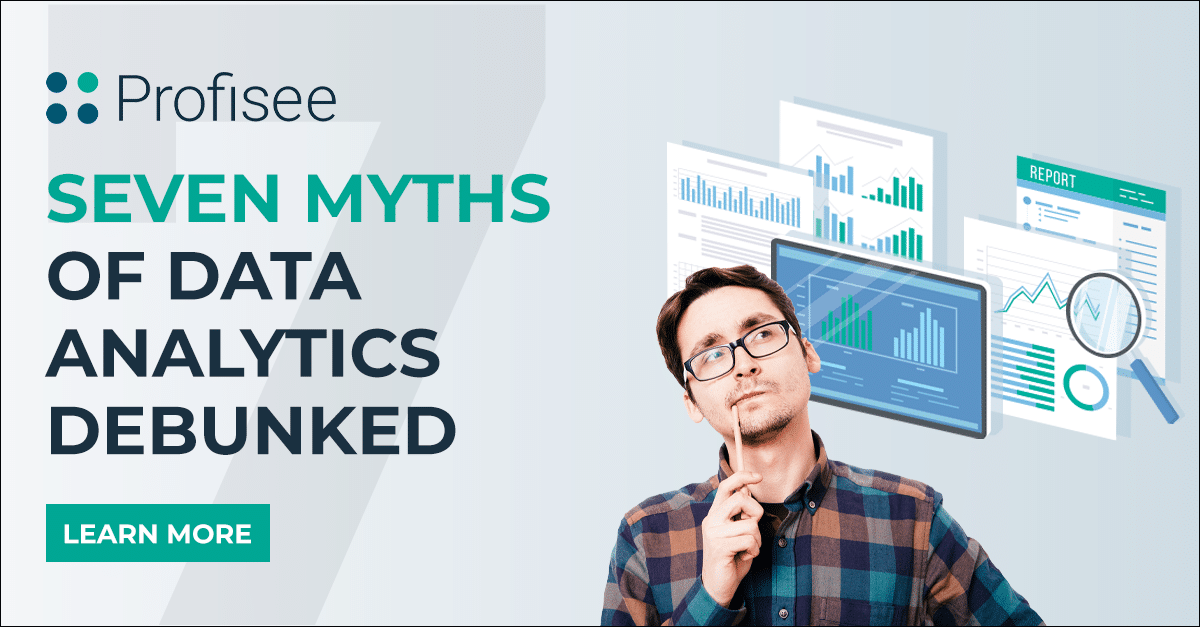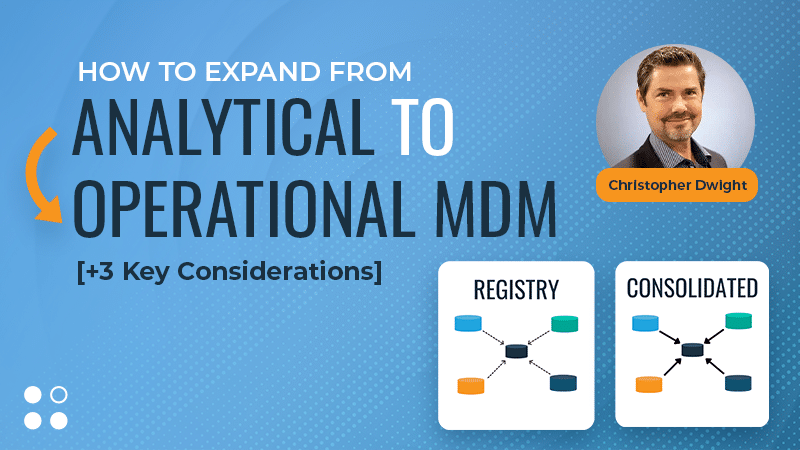The rapid growth and success of the data analytics field has a dark side.
It has led some in the field to fall victim to myths on what can be achieved with data analytics. At their worst, believing these myths can set data experts up for failure. To keep data enthusiasm high and to provide valuable & useful insights from your data analytics initiatives, focus on debunking these 7 myths.
Myth 1: That all data is created equal in analytics
A common theme many companies have is that ‘good enough data’ is good enough and this level of data quality is going to drive world-changing insights. The problem with this view is that it completely ignores data quality and strategy.
In a large organization, you will have terabytes and more of data. What is worth your time to analyze? That’s the strategy question. Next, you need to explore the quality of the data you do have.
Myth 2: Predicting the future is easy with data analytics
Another data analytics myth you hear is that predicting future behavior or actions is so easy with a data management strategy. But if the strategy doesn’t include master data management in support of data analytics, then what happens for example, when you open a new division of your company? Alternatively, you wonder if you should double the marketing spend for your top product? According to some gurus, data analytics can solve these types of issues by predicting the future.
For the most part, that is just not possible especially without
a master data component.
The reality is that predicting the future is more like probability analysis and recommendations. At their best, you have value-creating predictions like Amazon’s recommendations engine. At their worst, predictions give you false confidence. Our advice? Approach prediction and forecasting with caution. Make a lot of small bets and gradually test your models and make sure you have a clear data management strategy at the core of your analytics program.
Myth 3: You need to hire a team of data scientists
A few years ago, building a data analytics function required top of the market data talent. That’s still needed if your organization wants to produce cutting-edge data products and software.
For the rest of us? You can go a long way through a combination of three factors.
First, set realistic data analytics expectations based on your existing talent and data quality. Second, expertise still matters, but you can go a long way by hiring staff with Certified Analytics Professional (CAP) credentials and encouraging existing staff to earn this data certification as well. Third, equip your data team with high-quality data
to fuel their efforts.
Protip: That’s where master data management plays a vital supporting role in creating a trusted data foundation.
Myth 4: You need a billion dollar data budget
Years ago, this myth was true. It used to be difficult and expensive to create a data analytics department. That’s started to change. You already know that a small army of statistics PhDs is not required. What else is wrong about this myth?
There are three falling costs that make data analytics more accessible
in today’s market.
- The cost of data storage – especially in the cloud – continues to fall. An Infoworld analysis of cloud storage prices found that Amazon AWS, Microsoft, Google, and IBM have lowered their cloud prices.
- The cost of using data analytics software has come down. You no longer need to buy multiple software packages to achieve your goals.
- The ease of collecting more data than ever before through mobile devices and Internet of Things (IoT) platforms.
Add it up and you have a huge volume of data to execute a well-planned data management strategy at a much more affordable price than ever before.
Myth 5: Data analytics requires a massive volume of data
“Big Data” enthusiasts love to speculate about what can be achieved with vast databases. Sure, vast datasets play a role in the success of Google, Facebook, and Amazon. However, that’s not the only way to go.
With just 1,000 records, you can carry out meaningful data analytics. For example, if you had a thousand invoices from your largest supplier, you could run a small analytics project against that data to look for patterns. Even better, most organizations are already sitting on significant data resources.
Whether you have vast databases or not, the critical importance of asking good data questions and understanding data quality will always matter.
Myth 6: Data analytics can improve every part of your business
“Data solves all problems! If only you give us enough budget and tools, we can solve everything.” These kind of naïve statements gives data experts a bad name. We’ve found that today’s data analytics tools are highly capable in some areas and
weak in others.
Want to analyze an online marketing campaign? That’s an area where there are many analytics tools available. Curious to analyze production, customer orders or finance data? Those are also good areas to probe with data analytics.
Which manager should you promote to the executive level? What does Brexit mean for your campaign? Should you cancel a struggling new product? Those are questions that data analytics can’t solve. A focused approach to solving critical business questions with a trusted data foundation is at the heart of where companies are best served by a data analytics strategy.
Myth 7: Data analytics is only for online companies
While there’s an element of truth to this myth – tech companies have been among the most successful adopters of analytics, for example ad spend (and the ensuing data analytical insights) at Google and Facebook has generated billions of dollars in revenue. But, what about the rest of us?
Data analytics might not be a key component of the products and services you sell. However, data analytics do still matter as a way to enhance decision making.
Data analytics methods are also critical in supporting continuous improvement products. Just look at what Domino’s Pizza has been able to do by focusing on creating a trusted data foundation to support their marketing campaigns. Domino’s has transformed from a pizza restaurant to a technology company that sells pizza!
Your Takeaway
Go into data analytics projects with your eyes wide open. Using tried and true principles like master data management to produce clean trusted data as the foundation of your data management strategy will enable your success.
If you regard data analytics as a powerful resource rather than a magic wand, you will have debunked these 7 myths and truly feel the benefits with satisfied subscribers of your data analytics program and nothing can dampen your data enthusiasm then!







